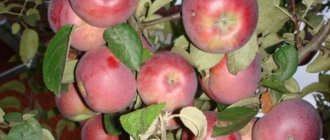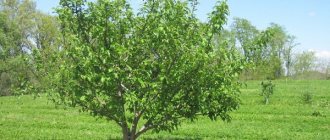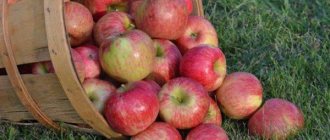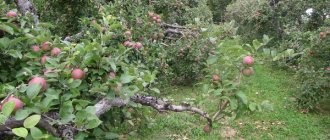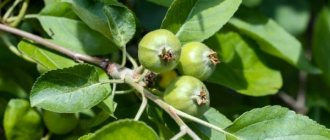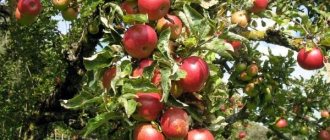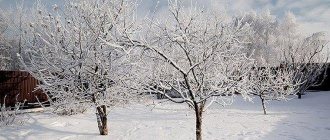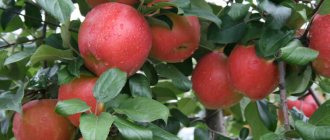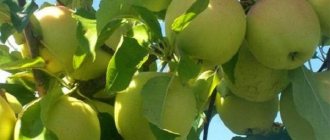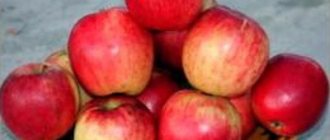In cold areas it is often difficult to grow any crops. Not all varieties of apple trees grow well in the northern part. Even if the apple tree produces a harvest, it is tasteless and of small quantity with small, tasteless fruits. Several years ago, breeding scientists, conducting crossbreeding, obtained a new variety, which was called the Bayana apple tree. The Bayan apple tree variety began to spread very quickly, as it had a peculiarity. Because of this feature, many gardeners began to plant it in large quantities on their territories, especially gardeners from the northern part.
Bayan apple tree: photo of variety
What does the Bayan apple tree variety look like?
What is this feature of the Bayan apple tree? And such that it can withstand severe frosts, while bringing a good, high and high-quality harvest. The temperature at which it develops does not matter much to it. The crossing was carried out of one variety with an artificially bred hybrid.
After various checks, the Bayana apple tree variety went on sale and is still popular due to its high resistance to frost.
Apples of the Bayana variety are quite large, usually about 140-180 grams, round in shape, resembling a ball. The shell of apples is without unevenness, very dense, so it does not crack or shrink under the influence of frost. The fruits are yellow in color with a slight green tint.
Advantages and disadvantages
The advantages of the Bayana variety are not limited to cold resistance; the apple tree shows good productivity, early ripening, and no frequency of fruiting. Fruit ripening may be slightly reduced during rainy seasons with large temperature changes in spring and summer. The variety is resistant to common fungal diseases, the fruits are well stored and can withstand transportation.
Disadvantages: low yield in the first seasons of fruiting, shedding of the ovary during ripening.
Bayan apple tree: when to plant?
Planting of the Bayan apple tree is usually carried out in the spring or autumn. If planting is done in the spring, then this is done before the buds begin to bloom; they should be in a “dormant” state. If planting is carried out in the fall, then a few days after all the leaves have fallen from the trees.
But in cold regions, it is better to plant the Bayan apple tree in the spring, since over the summer the tree has time to get stronger and settle down at the planting site. After such an adaptation, it will be easier for the apple tree to survive the winter.
Apple variety Bayana: photo
How to land?
First you need to prepare the hole. It is dug up, and it must correspond to the size of the root system of the seedling. Typically the hole size is 70 centimeters wide and 85 centimeters deep. At the very bottom of the hole you need to lay a large layer of soil mixed with 4 kilograms of humus and 50 grams of potassium sulfate, as well as 5 grams of superphosphate. All these components must be well mixed with the soil. By bringing this fertilized soil into the hole, you need to form a small hill from it, on which the seedling will be installed. After installation, you need to distribute the root system throughout the hole and fill it with soil. In this case, the soil must be compacted a little to firmly fix the roots. After everything, you need to water the apple tree using about 10-20 liters of water.
Note: Fertilizer for the Bayan apple tree should be applied only in the amount that is written on the instructions or recommended by a specialist. Excess fertilizer will have a very detrimental effect on the apple tree.
What distance should be between cultures?
When mass planting, you need to keep the distance at which the trees will be located. This is considered mandatory as it has a strong impact on development. There should be at least 420-430 centimeters between apple trees. This distance will allow the sun's rays to reach all the trees, while all the apple trees will develop well and bear fruit.
Bayan apple tree: photo of variety
Landing Features
The place for the seedling is chosen to be sunny, with a low groundwater level. Low-lying areas where melt water stagnates are not suitable for planting apple trees.
Landing
Particular attention is paid to the choice of planting material. The seedling for planting is chosen to be 2 years old with a well-developed root system. The trunk should be straight, the bark without damage.
Distance
When planting seedlings, you need to take into account the size of an adult tree; for good fruiting, the apple tree needs a sufficient amount of sunlight. The distance between plants is 4 meters, and between rows - 5 meters.
Distance from the apple tree on the site.
Deadlines
Apple trees are planted in the spring before buds begin to bloom and in the fall, after leaf fall. In the northern regions, experienced gardeners advise giving preference to spring planting of seedlings.
Technology
- To plant a seedling, dig a hole 60 cm deep and 90 cm in diameter.
- The top layer of soil is mixed with 2 buckets of humus, 60 grams of superphosphate are added and mixed.
- Fill the hole 2/3 full with the prepared mixture and make a mound.
- They drive a stake and plant the seedling, straighten the roots and cover it with earth.
- The soil is compacted, the plant is tied to a stake and watered with 2-3 buckets of water.
- The hole around the trunk is mulched with sawdust or dry grass.
- Leave the root collar 3-5 cm above the soil surface.
Step-by-step scheme for planting apple trees.
Pollinator varieties
Some sources talk about the self-pollinating nature of the Bayana variety, but experienced gardeners advise planting apple trees nearby with the same flowering and fruiting period. This will promote cross-pollination and more ovaries will be formed. These varieties will be apple trees:
- Cherry;
- Bolotovskoe.
Bayan apple tree: care for the variety
After planting the Bayan apple tree, you need to pay great attention to proper care of the apple tree. Care will contribute to the development and growth of the apple tree, as well as a good harvest. Care consists of watering, especially in hot summers and dry weather, weeding and loosening so that the soil is clean and well conducts oxygen to the root system, whitewashing the apple tree trunk, and prevention, which consists of treating with various preparations. And, feeding is also important, which is necessary for the normal functioning of the tree.
Pruning the Bayan apple tree
It is imperative to form the crown of the Bayan apple tree so that all branches receive the sun's rays. And the sun will influence good fruiting and ripening of fruits.
Pruning the Bayan apple tree involves removing dry shoots, branches and leaves, weak branches that are thin and do not bear fruit. On average, the branches should be the same length and in the same direction.
Ripening and fruiting of Bayana
Beginning of fruiting
Among Siberian apple trees, this variety is distinguished by its enviable early fruiting. Already 3-4 years after planting, it brings good harvests of 5-10 kilograms of beautiful, tasty fruits. The first fruits are no different from those that will come later, so you can use them in any way you like: store them, prepare compotes, lies, jams.
Flowering time
This indicator can vary significantly depending on the growing region and the prevailing weather and climatic conditions there. However, in most cases, large and beautiful, snow-white buds with a light light green tint bloom at the end of May. Flowering lasts for about 10-14 days, long enough for the bees to complete their task.
Fruiting and growth
This apple tree grows slowly, and after the start of fruiting it grows by about 7-15 centimeters per year. Therefore, only by the age of 10-12 it can reach 3-3.5 meters, at which it is better to limit it for ease of care and harvesting. At the same time, her fertility also increases gradually. Full harvests can be obtained only by 9-11 years.
Apples ripen around the beginning or middle of September, but everything directly depends on the weather. When it is dry and warm, the fruits ripen earlier and can be collected in the middle of the month. Finding out when it's time to pick apples before they fall to the ground is simple: a clear purple tint appears on the skin. Such apples are stored for about 4-5 months, after which they become loose, sour, and begin to wither and rot.
Top dressing
- Superphosphate.
- Potash fertilizers.
- Compost.
- Humus.
- Manure.
What to do if it doesn’t bloom or bear fruit
- Check for pests and diseases.
- Transplant.
- Limit watering.
Pollinator neighbors of the Bayan apple tree
Since all varieties of apple trees are of the self-sterile type, they must be fertilized. To do this, another variety is planted next to it so that they fertilize each other. Otherwise, there will be no harvest, since the ovaries will not form.
Well-suited varieties are pollinators of the Bayan apple tree, which can also grow in cold climates, and at the same time the variety should be winter, at best, and coincide in terms of flowering.
Bayan apple tree: photo of variety
Advantages and disadvantages
The Bayana variety apple tree has a number of advantages over other types:
- extraordinary winter hardiness;
- early start of fruiting;
- gives a lot of harvest;
- resistance to scab.
The disadvantages of this variety include:
- modest yield in the first years;
- some gardeners note that apples quickly fall off.
When does the first harvest appear after planting?
Once planted, there will be a harvest in the third year. This is a fast-growing variety, so the harvest will appear soon after planting.
Bloom
The Bayan standard apple tree begins to bloom at the very end of spring; the buds of the apple tree are very beautiful and have a rich aroma. The flowers are white with a slight pink tint, which can most often be seen in the sun.
Maturation
Full ripening of Bayan apples can be observed at the end of August or in the first half of September. It is very easy to determine the ripeness of apples of this variety; the fruits have a purple tint in color.
Bayan apple variety: photo of the variety
Subspecies and options
Semi-cultured
In spite of the harsh winters in the Northern regions of Russia, the Bayan apple tree is bred on a semi-cultivated seed rootstock:
- The fruit crop grows in the form of a bush or on a low trunk about 2 - 3 meters high.
- The fruits are smaller in size than the regular variety, weighing 100 - 130 g, with golden-purple stripes.
- The pulp is juicy, sweet and sour, aromatic.
- According to the tasting assessment, the taste qualities of apples are rated at 4.6 points.
- Semi-cultivated Bayan is a more frost-resistant variety.
- With proper care, the tree does not freeze even at low temperatures of -40 degrees.
You should know! In the semi-cultivated Bayan, the skin of the fruit cracks in rainy weather.
An apple tree of this variety can be grown as a bush or on a low trunk 2-3 meters high. This is a semi-crop on a seed rootstock. Differs in smaller fruits - up to 130 grams. It is characterized by increased winter hardiness.
It was obtained back in 1984 and was created as a frost-resistant crop, intended specifically for cultivation in remote areas of the Northern Urals and Siberia (Altai Territory). For this, two well-known varieties were used: Bellefleur - Chinese and Altai purple. Upon completion of serious testing of the new hybrid (studying the characteristics of its vegetation on various soils), it was confirmed that the issue of obtaining a frost-resistant apple tree was finally resolved.
In addition to the main variety, another interesting hybrid was bred called Dwarf, or Semi-culture, bred on a seed rootstock. This small plant can be imagined as a strong bush, just over 2 meters high.
After the appearance of the Semi-Kulturka apple tree for Siberia, the varieties of which stood out noticeably among other samples, the new species quickly spread throughout the northern regions of Russia, including the Altai Territory.
Additional Information! It quickly gained popularity among gardeners, replacing the dwarf varieties of apple trees for Siberia, the varieties of which were bred earlier.
With the advent of this hybrid, the often asked question of which apple tree to plant in Siberia was finally resolved.
Bayan apple tree: growing on rootstocks
The Bayana apple tree variety is often grown in Russia and is done using seed rootstocks. And it turns out that the Bayan apple tree develops like a bush, reaching about 180-220 centimeters in height. In this case, the fruits decrease in size and become approximately 70-80 grams, and a golden stripe appears on the fruits. The taste of apples remains the same as on mature trees. The taste is very pleasant and with a pronounced aroma, but tasters rate it slightly lower at 9.1 out of 10 points. With this cultivation, the frost resistance of the variety remains at the same level, the plant can withstand up to -40 degrees.
Note: This type of cultivation has a slight drawback; with a long period of rain, the shell of the fruit begins to crack.
Bayan apple tree: photo of variety
Reviews
Positive feedback from gardeners concerns the taste of apples and the long shelf life.
It has been noticed that temporary frosts are not dangerous for the variety, and insulation measures help in severe winter conditions. Young trees are completely covered for the winter using film.
The apple tree almost does not suffer from scab, but still requires preventive measures against other pests.
A problem for some gardeners has been the spreading crown, which makes harvesting and pruning difficult. To avoid such difficulties, the crown needs regular shaping.
In addition, due to the volume of the crown, the tree is not compact, which creates certain inconveniences for owners of small summer cottages.
How does the Bayana apple tree variety grow in cold regions?
The Bayana apple tree variety can be grown in the Urals, but this is quite difficult. The difficulty lies in the fact that you need to take into account some of the characteristics of the variety and carefully care for it.
The variety also grows in the regions of Siberia, but it is worth considering that with such frosts as there, the roots can become damaged and this will affect the tree. To prevent this from happening, it is necessary to cover and insulate the soil around the trunk by mulching with a thick layer and covering it.
Note: In areas with strong winds, it is necessary to install a support to the tree. To do this, when planting, a post is installed in the center of the hole, to which branches are subsequently tied. This protects the tree from having branches broken in strong winds.
Growing regions
Considering the harsh climatic conditions and variable weather in the Urals and Siberia, when growing this crop, certain care rules should be strictly followed.
- In Siberia. Despite its high frost resistance, the tree needs good shelter for the winter. The tree trunk circle is covered with a 10 cm layer of peat, and covered with fallen leaves on top. Before the shelter, in the fall, and in early spring, after its removal, the tree is whitened with slaked lime. This will prevent infections and sunburn on the tree.
- In the Urals, where there are frequent winds, a young tree must be tied to a support to protect it from breaking off shoots. Supports are installed next to mature trees. To improve the quality and quantity of the crop, the application of phosphorus and potassium fertilizers is required; the dosage and application rules are described above. To prevent fungal infections, trees are pruned annually in the spring.
Bayan apple tree: reviews from gardeners about the variety
- Ekaterina Viktorovna, Moscow region: “At first I was upset when I received the first harvest, because it was not as big as they told me. And then they told me that the only minor disadvantage of this variety is that the first year of fruiting the harvest will be of an average level, but in the second year everything will stabilize and the yield of the Bayan apple tree will increase.”
- Margarita Konstantinovna, Chelyabinsk region: “I was advised to start growing the Bayan apple tree variety by several neighbors in the dacha plot at once. Therefore, having succumbed to the persuasion and laudatory reviews of Bayan’s apple tree, I also decided to grow it. And what can I say: the variety really has frost resistance, the harvests of the Bayan apple tree variety are very rich every time, and the immunity of the Bayan apple tree variety to many diseases allows you to get a decent and tasty harvest.”
Bayan apples: photo of variety
additional characteristics
Advantages and disadvantages
The Bayan apple tree variety is outstanding for its combination of positive qualities.
The advantages of the variety include:
- High winter hardiness;
- Precociousness;
- Productivity;
- Immunity to scab.
significant deficiencies were identified in the fruit crop.
The only thing worth paying attention to is that in the first years of fruiting the apple tree has an average yield.
Dimensions of an adult tree
The tree has an average height , reaching no more than 4.5 meters by the age of 12.
The crown is sparse, broom-shaped, 3–4 meters in diameter.
Skeletal branches extend from the trunk at an acute angle, with a compact arrangement.
Annual growth
On average, the annual growth of horizontal branches is 5–6 cm, vertical branches 8–10 cm.
Frequency of fruiting
The variety is quite high-yielding, but in unfavorable years, periodicity is possible .
Productivity
At the beginning of fruiting, the yield, as a rule, is no more than 4 tons per hectare, with full fruiting - over 14 tons per hectare.
Fruits of the Bayan apple tree.
Tasting assessment
The fruits have an attractive appearance and creamy, juicy, excellent-tasting pulp. According to experts, the quality of the fruit is rated at 4.7 points .
Winter hardiness
The apple tree has good frost resistance , which contributes to its life in the northern regions of Russia. At low temperatures of 35 degrees, the tree rarely freezes.
Disease resistance
Good immunity helps prevent the development of scab or powdery mildew.
Important ! Diseases such as black cancer or cytosporosis can cause significant damage to the tree.
